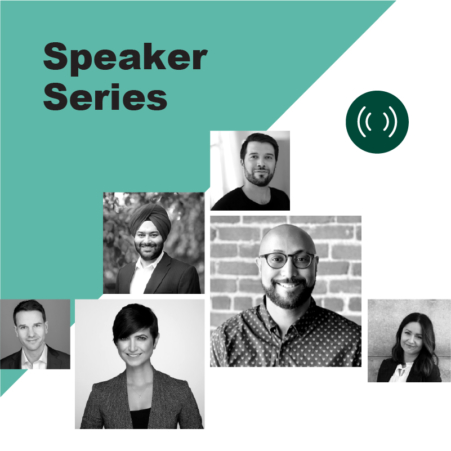Wherever we play in business, be it product, sales, design, or customer success, we fall in and out of love with tools and frameworks. But there is one framework that stands the test of time. What classic framework guides product managers to be more knowledgeable, valuable, and collaborative partners to their colleagues across the business? In this talk, LifeWeb 360 Head of Product, Tanya Maslach, shares three ways to position yourself as a product leader using the classic scientific method framework.
Join us for new conversations with leading product executives every week. Roll through the highlights of this week’s event below, then head on over to our Events page to see which product leaders will be joining us next week.

Every week, top executives share their insights in our Speaker Series. Don’t miss a single product conversation.
Reserve Your Spot
On the difference between product manager and product leader
According to Tanya, whether you’re an athlete or a product leader, you use some fundamental principles to do your work, and those are similar to what scientists use to do their work and they help you differentiate yourself as a product leader.
Tanya said product leaders are “long-term thinkers, so when someone is seven, and they want to be a gold medal gymnast, that is not going to happen in a quarter. It’s also not going to happen in two or three years. So they tend to look way, way, way down the line.”
“Secondly, they are both highly experimental and maniacal about what they measure. And so you’ll find that in, world-class athletes, academic research folks, or world-class business leaders. They are maniacal about measuring, and not just measuring anything, but measuring what matters against constantly experimenting.”
“And then finally, they are systems thinkers. So we’re all caught kind of in the weeds of the things that matter to us in our functions. But one of the things that we see from world-class athletes and business leaders, product leaders, one thing that they all do, like scientists, is they’re thinking about how what they do is impacted by the larger system, and how what they do impacts the larger system.”
On curiosity being a core component of a product leader
As children, we’re all naturally curious. Without preconceptions about everything we experience, we can constantly be in discovery mode, and that’s a great trail for adults, as well.
“When we’re little kids, we are literally little tiny scientists. We are unbiased, we are unbridled in our curiosity. We want to learn about anything, we want to touch anything because we have this experimental approach that is probably about eight seconds long. We see dirt, we have a hypothesis about it. And the only way to figure out whether a hypothesis is true is to taste it, right? So we’re looking under things, we’re pulling things out of the ground, we’re throwing our bodies against things. We’re just unbridled in our curiosity. That is a great thing, that experimentation.”
On the “five whys”, and getting to the root of a problem
The natural curiosity we all had as children was a prelude for future scientists, and also for product leaders.
“When we were little, we didn’t feel judged for being curious. We took time to be curious, we asked a lot of questions of a lot of people, and sometimes maybe it drove our parents or teachers crazy. The infamous “why, why why? What’s so funny about that, I think, is for those of us who’ve been operating in product for a long time, we know about the five whys. There’s an actual methodology now that we use to learn more about why a potential customer or a customer is having a problem. And the five whys allow us to dive deeper and deeper to really uncover the root of the problem.”
On the scientific method for product leaders
Tanya noted that though it was developed around 500 years ago by Sir Francis Bacon, the scientific method is useful for product development today. Three ways product leaders can use the scientific method include:
- “Observe actively; do not be a passive participant in what’s happening around you.
- Question assumptions, incentives and data no matter where it comes from.
- And experiment really quickly.”
About the speaker
Scientist by training, and entrepreneur by operation. * Intensely curious and asks why (a lot) * Approach is to think Better not just Bigger * Former startup founder/operator and proven results in large enterprise and small startups * Exceeds expectations while focusing on the long-term * Confident in presenting and persuading executives using verbal and written presentation. Proven results from leadership roles across the business, including; — software product management from ideation through go-to-market and growth, — customer success and accounts development and growth, — large scale project management, — managing teams and budgets, — organization process and development, — executive level Learning and Development — sourcing, hiring and leading teams Super powers: Curiosity Customer Empathy Disciplined and focused "I haven’t seen anyone drive things the way you have. I really appreciate you doing that for us. There’s a lot at stake here. I think you do a great job of making sure everyone is cognizant of that fact. Also, making sure to help people go outside their comfort level to do an awesome job." - Senior QA Manager, Sam’s Club "I know we didn't work much together but your HG Create seminar and overall energy had an impact on me. " - Digital Marketing, Katie G. Proven at working and realizing significant successes with small and large cross-functional teams in Engineering, Analytics, UI/UX, Sales, Merchandising, and Customer Service with teams in different locales. ”Judge a man by his questions rather than by his answers.” — Voltaire Personal: Breast cancer survivor, digital health startup advisor, collegiate swimmer, competitive endurance multi-sport athlete. . Published author: Chief Learning Officer, Global Leadership (Chapter on Leadership in book), Jossey-Bass chapter (Johnson & Johnson 30 page case study)